This was published 4 years ago
Tokyo city travel guide: Food to quirky fashion - best things to see and do in Tokyo
By Ben Groundwater
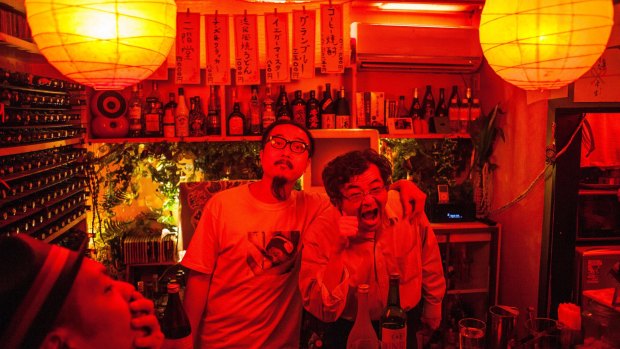
Golden gai alley in Shinjuku, Tokyo.Credit: Alamy
As if you needed another reason to visit Tokyo. As if the mind-boggling smorgasbord of cultural, traditional, futuristic and fantastic options wasn't already enough of a drawcard for visitors to the Japanese capital.
Now, Tokyo has major sporting events. In the coming months the city will host several Rugby World Cup matches, and in a year from now it welcomes the greatest sporting show on earth, the Summer Olympic Games. Add those highlights to the permanent embarrassment of cultural riches Tokyo has to boast, and you have one of the world's greatest destinations.
Of course the challenge for visitors to Tokyo at any point in time is simply figuring out what to do in this attraction-packed megalopolis, how to sift through the incredible amount of options available. How do you boil this place down into a reasonable set of experiences? How do you take these infinite possibilities and mould them into an enjoyable holiday?
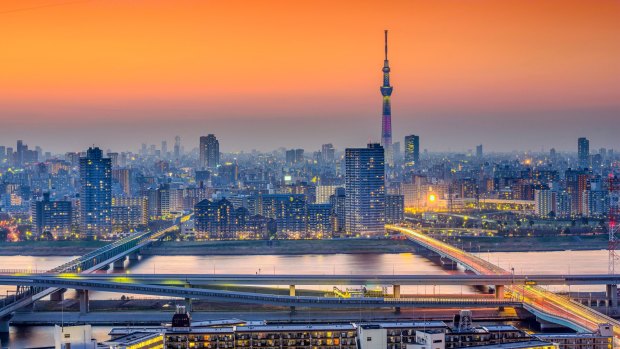
Tokyo's skyline at Sumida Ward. Credit: Alamy
The secret is to identify the aspects of Tokyo's brilliance that most appeal to you, and to build your stay around those passion points. Whether you're into food or art, history or modernity, music or sport – Tokyo has got you covered. And with the world's biggest events just around the corner, there's never been a better time to visit.
TOKYO FOR … FOODIES
WHY
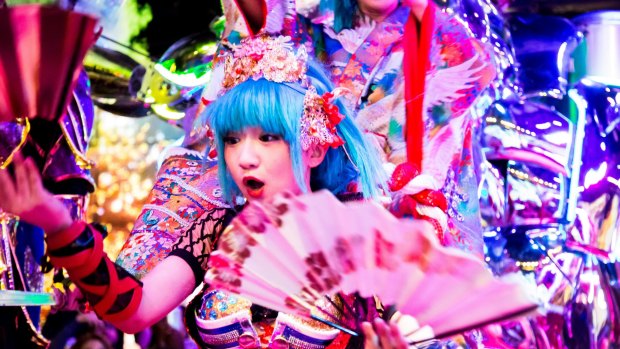
Performers at the Robot Restaurant in Shinjuku, Tokyo.Credit: Alamy
There is perhaps no greater city for those who love to eat than Tokyo. There's just so much to sample here, from the countless restaurants serving the myriad styles of Japanese cuisine, to a surprisingly high-quality selection of French, Italian, Spanish, Korean, and even American-style eateries.
WHERE
Though you can't go wrong anywhere in Tokyo, there are particularly good foodie hubs in Ginza, where restaurants range from Michelin-starred diners to raucous yakitori joints, Ebisu, with its friendly izakayas, and Asakusa, with its traditional restaurants.
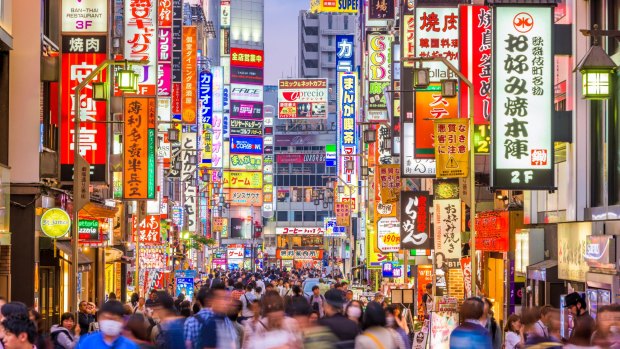
Crowds pass through Kabukicho in the Shinjuku district. The area is an entertainment and red-light district. Credit: Alamy
DON'T MISS
It's an impossible task selecting one experience visitors should have in Tokyo. The trick is to eat widely and fearlessly, and you'll never go wrong. It is worth highlighting, however, the "depachikas": basement-level food halls at major department stores that offer a saliva-inducing smorgasbord of the best foods from Japan and the world.
NEED TO KNOW
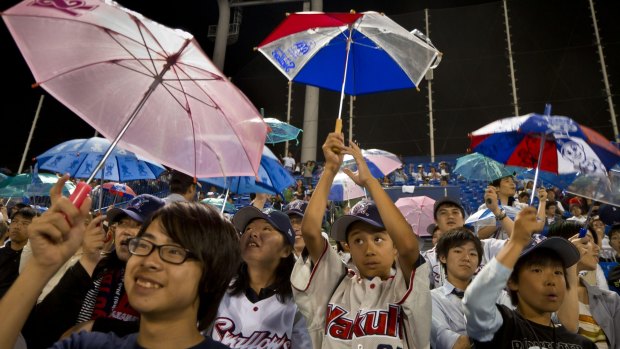
Fans of the Yakult Swallows Japan League baseball team sing and hold umbrellas overhead when one of their team's players hits a home run at Jingu Stadium.Credit: Alamy
Most high-end restaurants in Tokyo are cheaper to visit for lunch than dinner; tipping is not expected or required; and on the top two floors of most large train stations and department stores you'll find an excellent selection of casual eateries. For food tours, see urbanadventures.com
TOKYO FOR … SPORTS FANS
WHY
You don't get to host the Rugby World Cup and the Olympics without harbouring an admirable sporting obsession, and Tokyo has just that. This is a great city to go out to an event – football, baseball, sumo and more – and soak up the atmosphere.
WHERE
Tokyo's major sumo meets are held at the Ryogoku Kokugikan, near Asakusa. There are five tournaments throughout the year. Elsewhere, football and baseball stadiums are spread throughout the city, and for those who like to get involved, there's a baseball batting cage in Shinjuku.
DON'T MISS
Though Japan is most famous for sumo, Tokyo's heart belongs to baseball. The metro area has five top-tier teams, and perhaps the most enjoyable to see are the Yakult Swallows, whose home is the historic Meiji Jingu Stadium near Shibuya. The team's fans famously open umbrellas and sing whenever they score a run.
NEED TO KNOW
Live sporting events in Japan are safe and friendly. For sumo schedules and tickets, go to sumo.or.jp For baseball tickets, buy them at the stadium, or see japanballtickets.com For football, see jleague.jp
TOKYO FOR … HISTORY BUFFS
WHY
Though Tokyo doesn't boast the historic sites of Kyoto or Nara, there's still plenty for those who would like to get in touch with its Edo-era past. There's charm, too, in the city's not-so-ancient relics, visions of the future from architects of the late 20th century.
WHERE
The suburb of Asakusa oozes Edo-era charm, with its large temple and shrine, and quiet backstreets full of low-set old homes and family-run restaurants. Elsewhere, Kagurazaka still has a few geisha houses, the Imperial Palace gardens are an oasis of calm, and the Meiji Jingu shrine is worth seeing.
DON'T MISS
There's something seriously charming about the faded glory of Tokyo's recent past. Check out the amazing Nakagin Capsule Tower in Shimbashi, the Tokyo Tower in Minato, and the Yoyogi National Gymnasium for modern architectural history.
NEED TO KNOW
Most historic sites, aside from the Imperial Palace, are open to the public, and accessible via public transport. See jnto.org.au for more.
TOKYO FOR … TRADITIONALISTS
WHY
It may appear to be a bustling, hyper-modern metropolis with little time for the past, but dig a little deeper and you'll find Tokyo is rich with tradition. From quiet tea gardens to local-secret onsens; ancient festivals to cherished celebrations – there are always avenues into local customs.
WHERE
For cherry blossom viewing, head to the Meguro River, or Shinjuku Gyoen. There are excellent tea gardens in the west of the city, near Shinjuku (Kantoku-tei) and Komagome (Rikugien); onsens in Itabashi, in the north-west; and Asakusa is best for festivals.
DON'T MISS
For Tokyo residents, hanami, or cherry-blossom viewing, isn't just about the flowers, but the social engagement that comes with spending a day at your favourite spot. To join locals in this cherished tradition, take a blanket, some food and drink down to Shinjuku Gyoen during cherry blossom season and settle in.
NEED TO KNOW
Most Tokyo traditions come with their own etiquette. Before you visit an onsen or a tea house, or take part in hanami, it's best to read up. See jnto.org.au
TOKYO FOR … NIGHT-OWLS
WHY
The day never ends in certain parts of Tokyo, where neon glows and bars heave and pavements bustle, where long nights morph into early mornings and the cycle just begins again. This is a city where bars and restaurants, music venues and nightclubs, manga stores and gaming arcades just go on, and on, and on.
WHERE
Tokyo's true late-night hubs, where the action continues after the trains have stopped, are Shinjuku, Roppongi, Shibuya and Shimokitazawa.
DON'T MISS
Tucked deep in edgy Shinjuku, the Golden Gai area is a blast from the past, a network of narrow alleys and passageways lined with tiny bars, some of which can seat only four or five patrons. There's everything from rock'n'roll dives to classy whisky bars to quirky themed joints.
NEED TO KNOW
Nightlife in Tokyo is largely safe; you might notice a few shady characters around Kabukicho in Shinjuku, but foreigners who get in trouble here usually have themselves to blame. A lot of bars have a cover charge; the vast majority are welcoming to foreigners. See jnto.org.au
TOKYO FOR … MODERNISTAS
WHY
Tokyo is the future. It's a vision of a hyper-modern world, where vending machines ding and chime, giant advertising hoardings call from skyscraper walls, trains zip above and below, and robots provide entertainment for humans to observe. For those who cherish modernity, this is utopia.
WHERE
Ground central for Japan's tech boom is Akihabara, where streets are lined with giant electronics stores selling the latest gear. Ikebukuro is similarly well stocked, while Shinjuku has all of the lights and chimes, and Shibuya has the best of everything.
DON'T MISS
Two experiences, both ultra-modern, though on different ends of the class scale. In Shinjuku, the Robot Restaurant is dinner and a show, though you won't want to eat the dinner, and you'll be stunned by the overblown ridiculousness of the dancers-and-robots show. On the flipside, teamLab Borderless in Odaiba is a multi-sensory digital art experience that's a must.
NEED TO KNOW
You can't miss the modern side of Tokyo – it's everywhere you look. See jnto.org.au
TOKYO FOR … SHOPAHOLICS
WHY
Tokyo has everything. If you want to buy high-end vintage clothes, you can do it in Tokyo. If you want to buy unique designer apparel or budget-friendly basics, you can do it in Tokyo. There are also uncountable stores selling homewares, gadgets, knick-knacks, electronics, food, retro camera gear, sporting equipment and more.
WHERE
For department stores of every shape and size, go to Shinjuku. For luxury brands, Ginza is your spot. For high-end vintage, check out Shimokitazawa or Koenji. For modern fashion, try Shibuya or Omotesando. For kitchenware, go to Asakusa. For beautiful fabric, try Nippori. For edible produce, look everywhere.
DON'T MISS
Food lovers, head to Kappabashi Kitchen Street in Asakusa, where you'll find high-end knife stores, places selling handmade crockery and cutlery, and even shops specialising in the plastic models of food you see outside local restaurants.
NEED TO KNOW
Take your passport when you go shopping in Japan – some large department stores offer their goods duty-free, with instant cash back.
TOKYO FOR … CLASS-TAKERS
WHY
The best way to properly understand Tokyo, as well as return home with a few new skills, is to take a class. You might learn traditional calligraphy, origami, cookery, bonsai, flower arrangement, taiko drumming, or even sword-fighting – the trick is just to get involved.
WHERE
There are specialist schools for all of the activities mentioned above, as well as many others, spread throughout Tokyo, though you'll find the bulk in tourist-friendly areas such as Asakusa, Ginza and Shibuya.
DON'T MISS
Anyone who's stayed in a traditional Japanese house will have noticed the importance of ikebana, an elegant form of flower arranging, to the harmony and balance of a home. Visitors can learn this technique at Ohara School of Ikebana in Omotesando see ohararyun.or.jp
NEED TO KNOW
The only set rule for any class in Tokyo is to respect the art form, and respect the person teaching it to you. And have fun. See jnto.org.au
TOKYO FOR … MUSIC FANS
WHY
Tokyo might march to the beat of its own drum, but it dances to the beat of many others. This is a city that loves music, particularly live music, from cheesy J-pop to smoky blues, from ear-melting punk to smooth jazz. There are also plenty of bars that play every obscure genre of music you could imagine, and record stores peddling the finest vinyl.
WHERE
Music venues in Tokyo are known as "live houses", and they're concentrated around Shibuya, Shinjuku and Ebisu, with some excellent smaller venues in Shimokitazawa and Koenji. Vinyl hunters should head to Shinjuku or Shibuya.
DON'T MISS
Your choice of live house will depend upon your genre preference. Every music fan, however, should spend an evening in a bar like Martha or Track, both in Ebisu, where vinyl-nerd DJs cover a wide range of eras and styles, utilising some of the most expensive vintage stereo equipment you'll ever see.
NEED TO KNOW
Most live houses sell tickets on the door, and you won't need to book ahead. See tokyogigguide.com for listings.
TOKYO FOR … ART LOVERS
WHY
There's a rich artistic heritage in Tokyo that stretches back to the woodblock prints of Hokusai, to traditional calligraphy and beyond. There's also a wealth of great modern art, characterised by the boldly coloured pumpkins of Yayoi Kusama, and the unmistakable style of Japan's manga artists.
WHERE
The bulk of Tokyo's major exhibition spaces are in Ueno (home of the Tokyo Metropolitan Art Museum, and the National Museum of Western Art), Aoyama/Harajuku (the Nezu Museum and the Watari-Um Museum of Contemporary Art), and Roppongi, where you'll find the Mori Art Museum and the National Art Centre.
DON'T MISS
Outside of those big hitters, be sure to book well in advance to tour the new Yayoi Kusama Museum (yayoikusamamuseum.jp); and call past the excellent Yoseido Gallery in Ginza to buy original woodblock prints. See yoseido.com
NEED TO KNOW
Many large galleries are closed either Mondays or Tuesdays. See jnto.org.au for more.
FIVE PERFECT DAY TRIPS FROM TOKYO
YOKAHAMA
Tokyo's sister city offers many of the same attractions as the capital, only on a more manageable scale. Check out the historic port area, wander Chinatown, sample high-quality ramen, and go drinking in the rambling Noge area.
KAWAGOE
Set in Tokyo's north-western outskirts, Kawagoe is an Edo-period castle town that boasts a historic charm the Japanese capital often lacks. The main attractions here are the clay-walled Kurazukuri buildings, and the eponymous castle.
FUJI-Q
Thrill-seekers, rejoice: the Fuji-Q Highland theme park, about two hours west of Tokyo, features six roller-coasters, including two that were the world's fastest on completion, and one that flips passengers through a stomach-churning 14 inversions.
KAMAKURA
Jump on the train and head south for an hour and you'll arrive in Kamakura, once a seat of government, and these days a tranquil coastal town filled with temples, shrines and other historic monuments. The beaches are also popular in summer.
NIKKO
Nikko is a little further afield, a two-hour bullet-train ride north of Tokyo, but it's worth the effort to visit its beautiful national park, which teems with visitors when the foliage changes colour in autumn. It's a lovely break from city life any time of year.
EIGHT SECRETS TO A SUCCESSFUL STAY IN TOKYO
GET DATA
Tokyo is a colossal and confusing city, and you're going to need all the help you can get. For that, ensure you have internet access for your phone, either with your SIM card from home, or by hiring a Wi-Fi dongle from the airport on arrival.
BUY AN IC CARD
Your key to Tokyo's vast public transport system is an "IC" card, a prepaid swipe card that will get you onto the subway, trains, buses, trams and more. Look for ticket machines dispensing either Suica or Pasmo IC cards.
BOOK AHEAD
Some of Tokyo's best attractions – and indeed, all of its high-end restaurants – require bookings weeks in advance. The Yayoi Kusama Museum and the Studio Ghibli Museum are prime examples.
USE GOOGLE MAPS
This app, plus the data to use it, is your new best friend in Tokyo. Google Maps will help you navigate labyrinthine streets on foot, locate shops, bars and restaurants that only have Japanese signage, and plot the fastest routes using public transport.
SPLIT YOUR ACCOMMODATION
This city is huge, and it's easy to wind up spending a good chunk of your holiday just getting around. The solution is to split your accommodation between two major areas: for example, spend a few nights in Asakusa in the east, then move to Shibuya in the west.
EAT EVERYTHING (BUT NOT IN PUBLIC)
It's impossible to overstate just how good the food is in Tokyo. The only thing to remember is that it's bad form to eat on the run. Always sit down, even for coffee.
CARRY CASH
Though an increasing number of shops and restaurants in Japan accept credit cards, this is still a largely cash-based society, so stock up. The ATMs at 7-Elevens and post offices accept foreign cards.
DRESS WELL, BE POLITE
Japanese society is respectful and well-mannered, and it pays to follow these customs. That includes dressing well – as almost all Tokyo residents do – and being polite. This small effort will go a long way.
THE OLYMPICS: EVERYTHING YOU NEED TO KNOW
WHEN
The Tokyo Games will take place next year, from July 24 to August 9.
WHERE
The opening and closing ceremonies, as well as athletics events and football finals, will be held at the New National Stadium near Shibuya. Aquatics events, gymnastics, tennis, equestrian and volleyball will all be held at a cluster of venues at Tokyo Bay, while cycling will be at Izu Velodrome in Shizuoka.
WHAT TO LOOK FOR
Australians tend to excel in the pool, so obviously the aquatic events will be popular. Athletics, too, is always a highlight. The 2020 Games, however, also feature a few new events spectators will want to catch, including sport climbing, 3x3 basketball, and karate. The Olympic football tournaments – for men and women – will be played at venues around the country, presenting a good opportunity to escape Tokyo.
HOW TO GET THERE
Ticket sales for Australian residents are being handled by CoSport.com. Though the first major round of sales has already taken place, the website will be offering more tickets in various phases up to and during the Games. Accommodation in Tokyo is expected to fill up very quickly, so book as soon as possible if you plan to go. See Olympics.com.au for more.
Sign up for the Traveller Deals newsletter
Get exclusive travel deals delivered straight to your inbox. Sign up now.